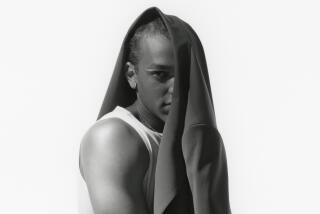How to Cure a Hangover : Some men may be in denial about their changing waistlines. But not clothiers, who are happy to cover a whole new market.
- Share via
David Bresler once strutted around in tight 501s and tapered oxford-cloth shirts. He could see his feet without bending over. And, best of all, he never had to suck in his gut.
But, like junk bonds and knit ties, those days are gone. Bresler, 50, has cultivated a belly--which his wife pats affectionately when she says: “Darling, I think Junior kicked.”
“It’s the effects of age and gravity,” says Bresler, a pain-control specialist and director of program development for the Los Angeles Healing Arts Center. “I can match each decade with the number of buttons I have to open after a good meal.”
Men of all ages can relate, particularly those who have graduated from disco and butterfly collars to desk jobs and Dockers. But unlike women, who often learn early in life ways to camouflage less-than-perfect bodies, they may be unsure how to cope when their bodies undergo, uh, the change.
“They don’t want to consider that their body has changed, and they buy their clothes the same as they did 20 years ago,” says Dianna Pfaff-Martin, founder of the Newport Beach-based California Image Advisers. “It’s a psychological thing. They don’t want to address the size factor. They don’t want to admit their measurements have gone up.”
Men’s expanding midsections have not gone unnoticed by clothing companies. Where stores once carried only the grandfatherly Sansabelt pants (now endorsed by Jim Palmer), with their nifty hidden elastic waistbands, they now virtually bulge with options. Farah and Savanne make pants with elastic waistlines, and Guess, Girbaud and Ralph Lauren offer larger and baggier cuts geared toward the larger man.
The Dockers label, which made Levi Strauss & Co. about $1 billion last year, was launched in 1987 specifically for sagging baby boomers. The company’s “relaxed silhouette” pants provide a looser seat and thigh, pleated front and tapered leg, says Tom Julian of the New York City-based Fashion Assn.
“It’s a huge business now,” he says. “The Dockers were nothing more than a casual weekend pant with pleats added for space, and as a result of their success, other companies have followed.”
Dallas-based Haggar Apparel Co., which for 67 years has offered its popular expandomatic waistline, has updated its styling and now features a “comfort fit” line.
“We’re seeing a trend to a more comfortable, relaxed fit,” says Carla Morgan, manager of investor relations for the company. “We’re finding that as baby boomers age and move out of their tight-fitting jeans, they are looking for a little looser fit.”
When selecting pants, experts say, men with thickening midsections should focus on the fit, not the size.
“Often a man wants to be a 34-inch waist when he should be a 38,” Pfaff-Martin says. “But the viewer will not see a Size 34--they’ll just see that he has too big a tummy. A pant that is too small will accentuate the tummy.”
It’s equally important to wear pants and jackets in the same color and to avoid shirts in loud prints. “There should be a solid line of color, so the viewer’s eye makes one continuous sweep,” Pfaff-Martin says.
Mickey Smith, 36, acknowledges that he no longer feels as comfortable as he once did in his jeans.
“When I was younger, I could wear my blue jeans and tight white T-shirt and it felt great,” says Smith, a West Hollywood sales representative whose 32-inch waist has expanded to nearly 35 inches. “I can’t do that and feel the same anymore.”
Many companies--including Liz Claiborne, Donna Karan, John Henry, Guess, Girbaud and Dockers--offer full-cut shirts, and Ralph Lauren’s full-cut “Big Oxford” is 20% larger in the torso.
Smith has switched from tapered to full-cut shirts and says he avoids sweaters because they make him feel even bulkier. For warmth, he wears an untucked, unbuttoned flannel shirt over a T-shirt.
Business attire, however, isn’t so easily adaptable. And some men complain that, even after alterations, off-the-rack suits rarely fit well.
“I’m just a big guy--an out-of-shape jock,” says Terry Wolfe, 40, a former college athlete who is 6 feet tall, weighs 300 pounds and has a 40-inch waist and a 60-inch chest.
“The suits usually have the same waist as chest, but when you try to take in the pants, you wind up with one pocket in the center of your back,” laments the Newport Beach mortgage banker.
Michael Heitland, owner of MJH Co. in Costa Mesa, offers custom-made suits made from a paper pattern of a client’s measurements.
“The alternative is finding a ready-made garment with the measurements set in, but it never comes out right in the end,” he says. “When you alter it, it throws off the balance.”
Heitland, whose suits start at $800, says proper tapering of the coat around a bulging midsection is critical. “If that’s wrong, (it) will accentuate the problem that is trying to be concealed. Most men make the mistake of selecting a garment that is the correct color but not the correct cut in the midsection.”
Double-breasted suits are slenderizing for men taller than 5 feet, 8 inches, Heitland says, but may add breadth to shorter ones. He notes that jackets should fit comfortably around the stomach without pulling or stretching when buttoned.
Extra-long ties that stretch over an extended stomach to the top of the belt are also essential, Pfaff-Martin says.
At the Brooks Brothers store Downtown, where the clientele includes many middle-aged men on the heavier side, salesman Richard Miller issues standard recommendations.
“They need to get the longer-rise trouser, which comes up higher to go around the stomach,” he says. And “for guys who have a hard time keeping pants the way they want them, suspenders are more comfortable (than belts). They’re also in style now.”
Some men, no matter what their stomach tells them, are reluctant to give up their personal style.
Bresler says suspenders remind him of Pa Kettle, although he might consider them in another decade. For now, he tries to keep a sense of humor about his waistline.
“Some guys seem to acknowledge (their guts) with a smile and wear their belts below their belly, letting it hang in their lap,” he says. “Other guys remain in denial. I guess I’m both.”
Camouflaging That Paunch
* Buy pants that fit around the natural waist; never wear pants below the belly.
* Be sure the pants’ rise--the distance from the crotch to the top of the waistband--is sufficient for the pants to reach up to the natural waistline. The waist can be altered; the rise cannot.
* Wear traditional, full-fitting shirts; avoid European tapering.
* Choose an extra-long tie that will reach over the stomach to the top of the belt.
* Try suspenders for a comfortable alternative to belts.
* Select suits in dark solid colors, muted pin stripes or herringbone pattern.
* Be sure the suit jacket stretches easily around the stomach.
* Consider a custom- or made-to-measure suit; they fit better and may not cost much more than altered off-the-rack suits.
* If you’re tall, a double-breasted suit will look flattering; if not, it will make you appear rounder.
* Buy a wool suit, if possible. The fabric drapes well on large men and moves with them.






